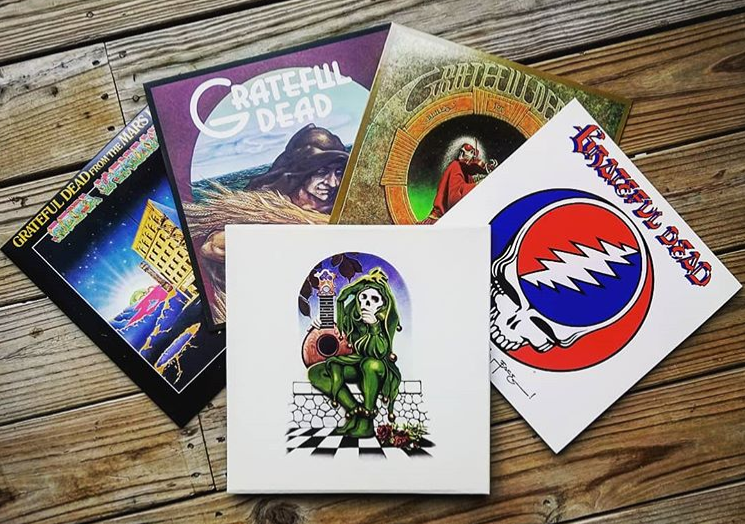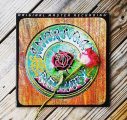A week or two ago I posted about my complete Mobile Fidelity Sound Lab collection of Grateful Dead titles on Instagram & Reddit. I’m back with more Dead because, with the addition of MoFi’s Blues for Allah release, I was able to finally do an A/B comparison with my favorite Dead studio title – Blues for Allah. I’ve gone through many copies of this album over the years; from a 1975 US 1st pressing in VG- condition to the 2017 Rhino release that was initially only available in the Record Store Day box set.

I actually ended up sticking with the Rhino release because to my ears it sounded wonderful and the media condition on the 1st press was creating too much surface noise. I sold the original pressing and keep only the Rhino, but I was always looking for something compare it against. For the longest time I had my eyes set on the 2011 release from the now defunct Audio Fidelity label. Prices always seemed to be north of 3 figures and I never felt the need to spend that much, just for the sake of doing an A/B, as I was already really happy with the sound on the Rhino copy. That said, when Music Direct’s 2019 catalog came out and had a photo of Blues for Allah with the “Original Master Recording” on the jacket, I lost my shit! I called Music Direct that day and asked to pre-order. After roughly 1 year of waiting, it was finally released; and it sounded absolutely stunning. I was still curious how it stacked up against the Rhino, although I had my suspicions how this would end based on past similar comparisons I’ve done.

Before I start comparing the two pressings, I wanted to share a bit about the album itself. Released in the early fall of 1975, Blues for Allah was the first studio release after the band had announced the then-indefinite hiatus from live touring. A small departure from their previous albums, where songs that had matured on the live stage were recorded for an album, “BfA” contained songs that were mostly written and developed in studio sessions in the early part of ’75. The album featured a mix of new genres and styles from lead guitarist Jerry Garcia, and marked the band’s most commercially successful album at the time; reaching as high as number 12 during a 3 month stint on the Billboard charts. The album was far more experimental than earlier albums like American Beauty and Workingman’s Dead (both which were based in the band’s late 60’s/early 70’s folk rock era), featuring elements of jazz and a slight dose of psychedelic rock. The album opens with a continuous flow of music from the segued Help on the Way -> Slipknot! 1st track, and seemingly morphs directly into the extremely catchy Franklin’s Tower. This is the first track that really gripped me on the album the first time I ever listened to it; with its repetitive refrain “roll away the dew”. The bouncing guitar riff featured throughout this tune was apparently inspired by Lou Reed’s Walk on the Wild Side, and once you know that you can’t unhear it! This opening segue makes for a perfect comparison track across the two pressings. What makes these perfect demo tracks to compare is that they will both start on the outer edge of the LP; chances of any IGD (inner groove distortion) will be limited – it won’t be something I have to adjust for in my analysis/rating. On both the Rhino and MFSL releases, these are tracks A1, A2, A3. Here are some details about each pressing below:
- Pressed By: Record Industry
- Masterd By: David Glasser
- Release Notes: 1LP at 33 & 1/3rd; housed in single pocket jacket, inside generic poly innersleeve
2019 Mobile Fidelity Sound Lab Release
- Pressed By: Record Technology, Inc. (RTI)
- Mastered By: Krieg Wunderlich
- Release Notes: 2LP at 45RPM as part of MoFi’s Gain 2 Ultra Analog series; limited to ~4,000
Before doing any listening, I took both albums to a local record store that has a an Audio Desk Systeme (a really expensive ultrasonic record cleaning machine) to have them cleaned. I put each into a new MoFi inner sleeve for safe and clean keeping. Then, before dropping the needle, I thorough cleaned the plinth to remove all dust, and used my Onzow ZeroDust to clean my stylus. My equipment used is as follows:
- Turntable – Pro-Ject Debut Carbon w/ Acrylic Platter
- Cartridge/Stylus – MoFi Electronics UltraTracker; nude elliptical stylus
- Phono Preamp – Parasound PPH100
- Receiver/Amp – Marantz SR7000 (using Direct mode for analog inputs)
- Speakers – Klipsch KG4

As noted above, I was going to focus my testing first on the 3 segued tracks. The dueling elements between 2 electric guitars playing separate riffs, and a really funky baseline, make for a unique listening experience; but this is also where mastering is going to be hugely important. If properly mastered and fully dynamic, you should be able to separate each guitar and pull out the bass. If it is not, the guitars will sound muddy and will begin to bleed into one another.
I started with the MoFi (initially forgetting to put my speed to 45rpm, and wondering for that initial second why everything sounded odd), and I was first caught by how little surface noise there was on the lead-in track. Usually you expect some level of hiss or a pop, but there was none to be found. Kudos to RTI on that one! The song began and I felt the volume was slightly low, so I turned the receiver up 2 clicks. Jerry’s guitar with it’s signature envelope-filtered sound is what grabbed me the most on first impression. The tone was crystal clear and you “feel” it right there in the room. I turned my attention to the second guitar which is isolated to the left channel for all of the first portion of the segue trio. It too was really clear, though I found it was probably mixed just slightly too low – it can get lost on occasion under the baseline…which brings me to my next observation. The bass on this MoFi release is absolutely WONDERFUL! It’s big, bold, and round while retaining clarity and realism. After a couple listens I decided the bass was probably the MVP of the MoFi copy. As Help on the Way -> Slipknot is about to transition to Franklin’s Tower, there’s a tambourine that I’m not sure I’ve ever fully heard (or payed enough attention to). It’s something that likely gets buried without good mastering; being cut at 45 doesn’t hurt the ability to retain dynamics, either. By time Franklin’s rolled around, I was dancing in my seat. Elements of an organ are nicely layered, and that tambourine sticks around. But it’s still the “jumpy” riff (the one mentioned about that supposedly was intended to mirror Walk on the Wild Side) that carries the song and music. With side A completed, I put away the MoFi LP, reset my turntable speed to 33 & 1/3rd, and put the Rhino press on the platter.
Upon dropping the needle, there was definitely some surface noise. I had never really thought anything of it, but I think after listening to the MoFi it just seemed like there was a bit of excess surface noise. When the music began, I immediately flinched because the output was much louder than the MoFi and I had to turn down the receiver 5 clicks. With the volume levels more or less equalized to what I had used for the prior version, I noticed the same thing – Jerry’s guitar just sounds so damn real. I’m going to chalk this up to a factor of being a great source recording since both releases were very impressive in this area. Once again, I still felt the left channel’s guitar to be slightly buried, though on the Rhino pressing the bass is a little more mild; so it does quite get lost in this version. I did feel that some minor details were lacking, though. The biggest thing that stuck out to me was that the aforementioned tambourine does really get muddied on this LP. I can hear it, especially being more aware of its presence now, but it is nowhere near as clear as it was on the first go-round. What was really impressive on this, though, is how clean the vocals come through. I felt the MFSL copy maybe could have mellowed the vocals a bit – they came across on the hotter end; not quite “harsh” but not “smooth” either. On the Rhino release, they have a silk-like quality about them (especially on the final track I compared, Franklin’s).
All in all, this ended up being much closer of a contest than I expected – though I really shouldn’t have been that surprised. When I did my 4-way comparison of American Beauty, I was shocked by how well the Rhino release of that album stacked up. It was far and away the only thing that went toe to toe with the 45rpm MFSL; not even the original 1979 MFSL could compare. Ultimately though, like that prior shootout with a Grateful Dead album, the 45rpm cut from MoFi was just too tough to beat. It really has everything you want in an audiophile release – clear and liquid-like guitars, great separation to allow small elements to shine through, and full/round bass. It does come with a premium price tag though, and that’s like a decision point for many people. Do you spend $50 on the audiophile grade album, or spend less than half that for the version that nearly stacks up to that lofty level of the audiophile grade release? Ultimately, it’s great for Dead Heads and vinyl lovers alike that there’s the options to choose from. High end sound quality is rare enough these days, so to be able to choose between two versions of an album that are in-press and widely available is a great thing! If you’re looking to save some change – go for the Rhino – you will NOT be disappointed in the slightest! But if you have the change to spare and you’re looking for the absolute top-end version; it’s the MoFi.
One last bonus note – the MoFi may be strongest on a tune I didn’t compare between the two. The Music Never Stops is one of my all-time favorite Dead tracks, and the dry saxophone in that track is absolutely breath taking on this release. The realism is unparalleled. I’ve been here endlessly replaying that track while writing this, tapping my foot constantly. When you hear a good song, and the sound quality is good, it’s almost impossible for me not to have some sort of physical reaction wanting to move to the music. I once was told, while demoing audio gear, that you can judge how good the quality is by whether a person taps a foot/nods their head/etc. Even if the music is not an artist/genre/song they like, when a person hears good quality sound to a beat or rhythm, it’s almost impossible to not have a reaction to that. And I wholly believe that!
Anyways, hope this wasn’t too long winded, and I hope that some got enjoyment out of this (I know my ears did doing the listening!)
If you liked this, check out my American Beauty review if you haven’t already (linked above), or some of my other previous reviews and write-ups:
Dave Brubeck Quartet Jazz Impressions of Japan | De La Soul 3 Feet High and Rising | Father John Misty Pure Comedy

